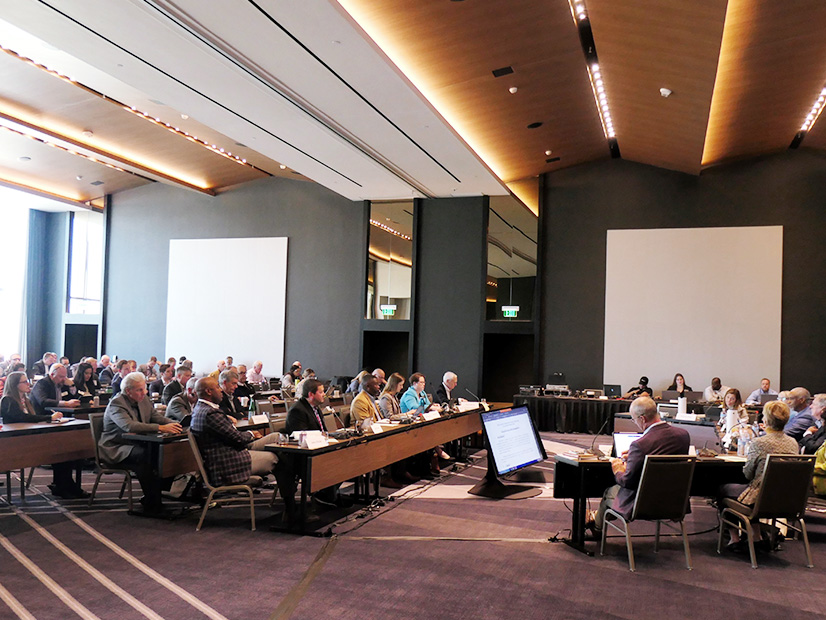
DALLAS — MISO’s conceptual, $20 billion, 765-kV transmission suggestion took top billing at Board Week, with some members asserting that MISO has even more transmission to plan if to meet the future confidently.
MISO earlier this month said it envisioned a $17 billion to $23 billion second long-range transmission plan (LRTP) portfolio with most lines rated at 765 kV. Many of the proposed line routes in the massive buildout track those approved under the first LRTP for MISO Midwest. (See MISO Says 2nd LRTP Portfolio Should Run About $20B, Rate Mostly 765 kV; MISO Outlines Benefits of New LRTP Investments.)
“This is the System Planning Committee of the MISO Board of Directors, and I’m going to tell you right off the bat, there’s nothing to see here,” MISO Director Mark Johnson joked when opening the March 19 meeting discussing the RTO’s grid-expansion activities.
“I can tell you today that we’re starting to glimpse the finish line,” MISO Vice President of System Planning Aubrey Johnson said of the second portfolio. He said MISO personnel have logged more than 25,000 hours to reach the blueprint.
Aubrey Johnson reminded attendees that MISO has said for years its members are contemplating adding up to $500 billion in new generation to achieve carbon reduction goals and that the RTO could recommend $100 billion in transmission projects to incorporate those resources into the grid over the next two decades.
“The generation expansion is driving the transmission we plan to marry to it,” he explained.
By 2042, MISO predicts it likely will manage 466 GW of installed capacity, have a 145-GW peak load that occurs in January rather than July and will have overseen 103 GW in generation retirements. Its fleet will emit 96% less carbon pollution than it did in 2005.
Senior Vice President of Planning and Operations Jennifer Curran said while MISO can’t pin down precisely what the future’s fleet resembles, the second portfolio is MISO’s “least-regrets” plan.
MISO Director Nancy Lange said MISO’s plan appears necessary to usher in the future resource mix.
“We’re trending toward the top range of the plan if I think about load growth, capacity accreditation,” she said.
Aubrey Johnson said MISO believes stringing 765-kV lines affords it more flexibility going forward and is preferrable to MISO recommending three 500-kV lines, three double-circuit 345-kV lines, or six single-circuit 345-kV lines for every single-circuit 765-kV.
On the other hand, MISO’s annual transmission planning cycle shows a preliminary $5.5 billion in more routine investments. (See Early MTEP 24 Designates $5.5B in Transmission Spending.)
However, Executive Director of Transmission Planning Laura Rauch said MISO’s information shows load growth is gaining momentum and she expects future annual transmission packages to include more spending on local transmission projects.
Members to MISO: More, Please
Some MISO members said the proposed 765-kV lines aren’t a match for future changes.
Clean Grid Alliance’s Beth Soholt said despite the billions of dollars in proposed projects, MISO needs “to keep going.” She said two of MISO’s three transmission planning futures are too conservative, especially considering recent load growth.
Soholt urged MISO to recommend and the board to approve the second portfolio expeditiously.
“There is a significant cost to not building transmission in a timely manner,” she said.
Xcel Energy’s Drew Siebenaler said while the first portfolio was “groundbreaking” and the second “has the potential to set us up for the energy future,” MISO should plan even more transmission.
The Grain Belt Express Question
Invenergy’s Arash Ghodsian asked MISO leadership to factor in planned merchant HVDC lines, like the Grain Belt Express, into LRTP efforts. MISO has said it will conduct a sensitivity that includes Grain Belt operations into its modeling but has not committed to rearranging the second portfolio to account for the merchant HVDC line.
Mark Johnson acknowledged publicly that Invenergy sent a letter to the MISO Board of Directors arguing the RTO is deficient in its LRTP planning because it has not contemplated the $7 billion, 5-GW Grain Belt Express in its latest LRTP portfolio.
“MISO does its very best to ensure that it has a very open and transparent process,” Johnson said, encouraging stakeholders to participate in MISO’s public planning meetings and voice concerns.
WPPI Energy’s Steve Leovy also said he’s worried about “MISO planning over projects” like the Grain Belt Express.
Invenergy’s letter said there is “no justification in the MISO tariff or otherwise for an inefficient planning process that disregards privately funded infrastructure development happening in MISO’s own footprint.”
“By ignoring the parallel efforts of merchant transmission developers in its LRTP, MISO has demonstrated an ongoing failure in planning,” Invenergy wrote. The company estimates MISO’s first LRTP portfolio alone contains more than a billion dollars in unnecessary costs because it ignored advanced-stage interregional merchant transmission.
Invenergy said MISO’s failure to include merchant HVDC lines is distorting its required cost-to-benefit analyses.
“It is time for the board to step in and prevent further waste, delay and policy outcomes inconsistent with those set out by” the Department of Energy, FERC, NERC and Congress, Invenergy told MISO directors.
Members Want Future Discussions on LRTP III’s Cost Allocation
At the March 20 Advisory Committee meeting, some MISO members asked that a future discussion be devoted to the cost allocation of the third LRTP portfolio, which will focus exclusively on MISO South transmission projects.
Regulators of states with Entergy companies have asked MISO to use an allocation that assigns 90% of costs based on adjusted production cost savings and avoided reliability projects, with the remaining 10% billed to new generation that interconnects in MISO South based on a flow-based methodology. (See Entergy States Debut Long-range Tx Cost Allocation Proposal, MISO Members Unconvinced.) MISO, on the other hand, has proposed using a blend of a 50% postage-stamp allocation to load and a 50% allocation to the local transmission zone for MISO South LRTP projects.
At any rate, the third LRTP portfolio is poised to use a different cost allocation than the first two Midwestern portfolios, which employ a 100% postage-stamp allocation to load. Any new cost allocation proposal will have to pass FERC muster.



